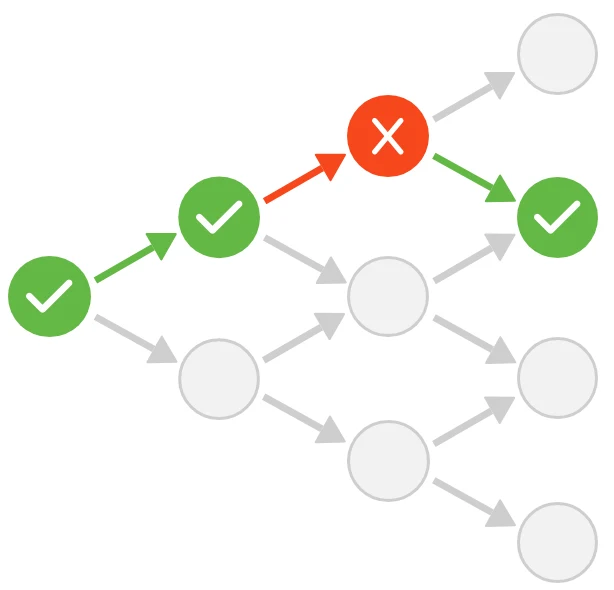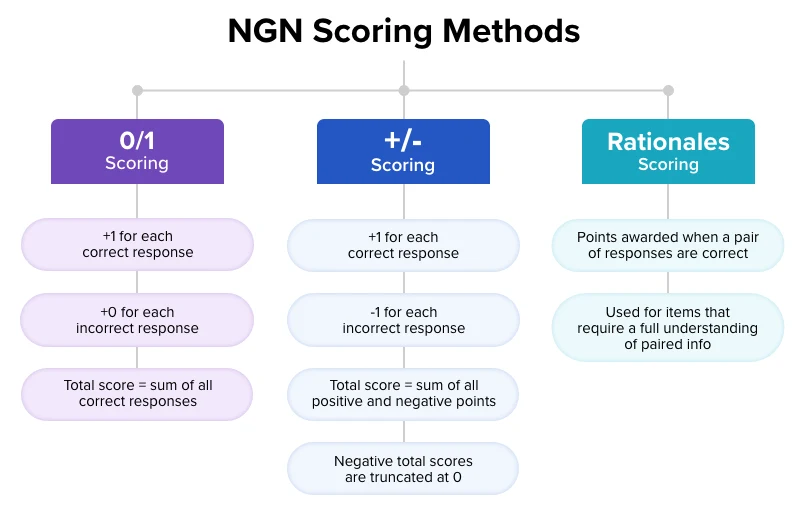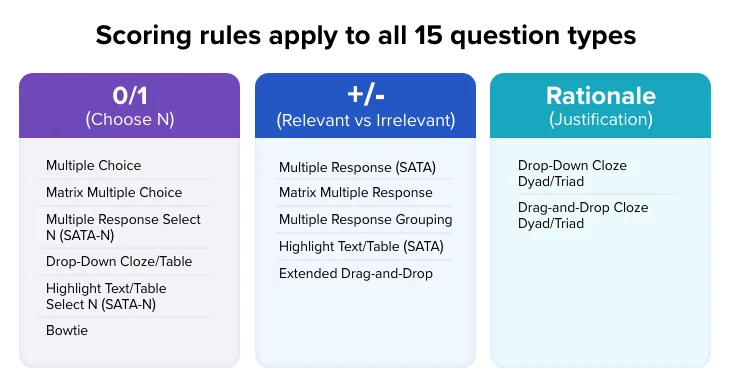NCLEX® Pass Rates and Scoring Guide
The Next Generation NCLEX® is an adaptive test that ranges from 85 to 150 questions. Learn about its historical pass rates and unique scoring rules to increase your chance of passing the first time.

NCLEX-RN and NCLEX-PN pass rates are released by the National Council of State Boards of Nursing (NCSBN) every year. Understanding what constitutes a "pass" and how the NCLEX is scored can be confusing, especially with the introduction of the Next Generation NCLEX's (NGN’s) new scoring model. This guide provides everything you need to know about NCLEX scoring, including pass rates for 2024, current passing standards and scoring methods, and more.
2024 Pass Rates for NCLEX-RN and NCLEX-PN
The charts below indicate pass rates for first-time and repeat test-takers in the U.S. and internationally:
2024 NCLEX-RN Pass Rates
2024 NCLEX-PN Pass Rates
| 2024 NCLEX-RN Pass Rates | |||||
| Candidates | Jan. - March | April - June | July - Sept. | Oct. - Dec. | YTD Total |
| First-Time, U.S. Educated | 94.15% | 92.72% | 89.19% | 82.21% | 91.16% |
| Repeat, U.S. Educated | 52.78% | 43.10% | 57.14% | 48.77% | 50.93% |
| First-Time, International | 58.77% | 54.09% | 54.50% | 48.37% | 53.81% |
| Repeat, International | 44.05% | 37.38% | 35.92% | 29.05% | 36.27% |
| Total | 79.08% | 77.75% | 73.39% | 55.74% | 73.26% |
| 2024 NCLEX-PN Pass Rates | |||||
| Candidates | Jan. - March | April - June | July - Sept. | Oct. - Dec. | YTD Total |
| First-Time, U.S. Educated | 91.09% | 88.31% | 90.04% | 82.60% | 89.38% |
| Repeat, U.S. Educated | 45.39% | 42.77% | 42.33% | 37.70% | 41.92% |
| First-Time, International | 51.65% | 51.09% | 62.045% | 39.42% | 51.14% |
| Repeat, International | 29.17% | 19.42% | 27.03% | 19.79% | 23.89% |
| Total | 82.38% | 77.87% | 82.62% | 71.59% | 79.07% |
You'll notice that pass rates among repeat test-takers are markedly lower than first-time test-takers. This is likely due to students following a poor study plan or using low-quality resources, then retaking the exam without making changes.
UWorld Nursing can help. We offer a learning system based on exam-level content that simulates the NCLEX in format and quality. We believe that if you treat practice like it’s the real exam, then the real exam should be as easy as practice.
How Is the Next Generation NCLEX Scored?
The NCLEX uses Computerized Adaptive Testing (CAT) to deliver questions that are tailored to your unique ability, which more accurately measures your competence. CAT uses an algorithm to display questions with varying difficulty based on your response to the previous question. Initially, you'll receive a question with a difficulty level near the passing score. If you respond correctly, the next question will be a little more difficult, or vice versa. The CAT algorithm is designed to present questions that you have a 50% chance of answering correctly. This process continues until 1 of 3 pass/fail rules is met.
What Are the NCLEX Pass/Fail Rules?
The NGN CAT algorithm determines whether you pass or fail based on 1 of the following 3 rules. These rules are sometimes referred to as the exam’s “stopping rules” that indicate when the exam will end.
- 95% Confidence Interval: The exam ends when the computer is 95% certain that your ability is above (pass) or below (fail) the passing standard.
- Maximum-Length Exam: If you receive the maximum number of questions and your ability is close to the passing standard, the computer will determine whether you receive a pass or fail score.
- Run-Out-of-Time (ROOT): If time runs out and you have not answered the minimum number of questions, you will fail. If you have answered the minimum number of questions, the computer will determine a pass or fail based on existing responses.
What Is the Passing Standard?
Every 3 years, the NCSBN convenes a panel of nurses to reevaluate the passing standards for the NCLEX-RN and NCLEX-PN. The NCSBN Board of Directors considers their recommendations and defines the competencies required to practice as an entry-level nurse. The 2024 passing standard for the NCLEX-RN is 0.00 logits and -0.18 logits for the NCLEX-PN.
Next Gen NCLEX Question Scoring Models
The Next Generation NCLEX includes new question types that better measure clinical judgment required by entry-level nurses in clinical practice. Along with the new question types, the NCSBN has also adopted more nuanced scoring models.
What Is Polytomous Scoring?
Polytomous scoring awards partial credit for correct responses on questions with more than 1 correct answer. Each answer option is assigned a point value. You are awarded 1 point for each correct response you select. So for a question with 3 possible correct responses, if you select 2 of the 3 possible, you will be awarded 2 points instead of no points as with traditional, dichotomous scoring.
How Are Questions Scored on the NGN?
NGN questions are scored by 1 of 3 methods: 0/1, +/-, or rationales. 0/1 scoring is typical of traditional multiple-choice items — you earn 1 point for selecting the correct answer and 0 points for an incorrect answer. +/- scoring awards points for correct selections and subtracts points for incorrect selections. Rationales scoring assesses items that require a justification for a rationale. For example, you must do X because of Y. Therefore, both selections must be correct to earn a point because X and Y are dependent on each other.
Which Scoring Rule Applies to Each NGN Question Type?
Each of the 15 question types is scored with 1 of the 3 scoring methods. For example, multiple-choice questions are scored with 0/1, multiple-response questions with +/-, and questions that require paired information with rationales scoring. The table below organizes question types by how they are scored:
How Long Does It Take to Get NCLEX Results?
Nursing Regulatory Bodies (NRBs) take about 6 weeks from an exam date to send NCLEX results. Although the computer scores your exam in real time, results are not released at the test center, and staff cannot access them. Instead, your exam record is transmitted to Pearson VUE, where it's graded a second time. If you haven't received your results within 6 weeks, contact your NRB. Do not contact Pearson VUE or the test center.
You may be able to access your results within 48 hours if your state offers the quick results service. However, quick results are unofficial. Before you can practice as a licensed/registered nurse, you must wait for your official results from your NRB.
What Is a Candidate Performance Report?
If you fail the NCLEX, you'll receive a Candidate Performance Report (CPR). This 2-page report includes the number of questions answered and information on performance within each of the 8 NCLEX content areas. Performance is rated as Below the Passing Standard, Near the Passing Standard, or Above the Passing Standard.
The CPR also includes the weight of content areas and descriptions of their related topics. Use this information in preparation for your retest. Prioritize the content sub-needs where you performed Below the Passing Standard, then Near the Passing Standard, but also continue to review areas where you scored Above the Passing Standard so you don't forget anything on your next exam.
How Many Times Can I Retake the NCLEX?
You can retake the NCLEX 8 times a year if you have applied for licensure/registration with your NRB. However, you must wait 45 days between each exam. Retake policies vary by jurisdiction, so make sure to check with your NRB.
What Happens If a Candidate Fails 3 Times on the NCLEX Exam?
If you fail the NCLEX 3 times and want to retest, you must complete a board-approved remediation program. However, this policy varies by jurisdiction, so contact your NRB for details.
Read More About the NCLEX
NCLEX Eligibility, Registration & Cost
You can't pass an exam you don't take. Understanding eligibility requirements and how to register for the NCLEX is your first step toward passing. Check out this guide for details.
There's a lot more to the NCLEX than how it's scored. Read this guide for critical information on how the exam is organized, its 8 content areas, question types, and more.
Studying for an exam is half the battle. The other is knowing exactly what to study and how to study it. Check out this comprehensive blueprint for the NCLEX-RN.
Don’t waste time trying to figure out what to study when you could be studying. This comprehensive NCLEX-PN study guide has everything you need to start preparing.
We’ll walk you through the NCLEX-RN Test Plan. Learn everything you need to know about client need categories, including their weightage and subtopics.
Dive deep into NCLEX-PN Test Plan. This guide elaborates on exactly what you need to study for each content area and the relative importance of each.






